There are several core cigar flavor components used to describe flavors one can taste while enjoying a cigar (see my other article called How to taste a cigar). Most of the flavors are derived from a scale used to describe wines (popularized by Cigar Aficionado, whose owners also publish Wine Spectator), as they share a lot in common. I have parceled things up into core flavors and within the core flavors, there are certain specific flavors that I will try to describe in detail, including the type of cigar in which these flavors are generally found.
But before I go further, there is often a lot of discussion around describing cigar flavors. Some feel that such descriptions are pompous and unnecessary. I do agree that sometimes these descriptors can sound a bit silly (i.e. pencil lead in a cigar???). But just like with wine, I think those that write about cigars use some sort of poetic license when trying to describe what they taste. Does anybody want to read a magazine where the cigars are reviewed as such: Cigar 1 – tasted like smoke, liked it; Cigar 2 – tasted like smoke, hated it…? Just like in a good book, adjectives and descriptors are used to help paint a mental picture for the reader.
So without further ado, here are the Core Cigar Flavor Components:
Plants

This component does not have as many colorful descriptors as some of the other core components, but every cigar has at least one flavor from this section.
- Grass – often found in milder cigars, most notably those that are Connecticut Shade wrapped. Candela cigars because of the retained chlorophyll also often carry this flavor.
- Hay – very similar to grass but with that extra barnyard component.
- Moss – a lot of mild cigars, generally from the DR and Honduras, can exhibit this flavor. It’s a cross between earth and grass with a bit of must. Puros Indios cigars have this flavor component.
- Tea – one of those elusive flavors. Reportedly present in heavily aged cigars.
- Tobacco – no stretch here that tobacco tastes like… tobacco. Usually this is used to describe a cigar that has a strong “tobacco core”. Cuban Partagas comes to mind.
- Wood – this is a big component in tasting cigars. To me most cigars have some sort of woody component to it. This is most easily detected in milder cigars that are wrapped in Connecticut Shade leaves.
- Cedar – a lot of cigars are cedar-aged (in humidors or en cedro) or boxed in cedar cabinets, so this is often a flavor that is imparted on the cigar after the leaves have been fermented and aged in the barns.
- Oak – some specialty cigars are oak cask-aged and some have this flavor naturally. It’s reminiscent of tannic qualities in wines, and is often accompanied with a dryness on the palate. Try the Aurora Barrel-Aged cigars for this flavor prominently on display.
- Smoky – when used it is referring to the flavor of smoked wood like hickory or mesquite.
- Vegetal – a general descriptor for a “green” plant-like flavor.
Spices and Herbs
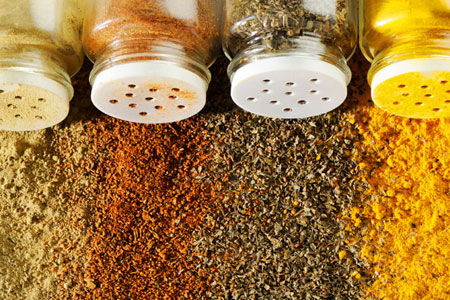
This section will be a little broad in what is considered a spice or herb, but I see it as a good area to describe kitchen/baking flavors.
- Anise – see licorice.
- Cardamom
- Cinnamon – mostly the “hot” cinnamon variety, a similar feeling to eating a Red Hot candy. Cigars loaded with ligero can express this flavor.
- Clove
- Cumin – kind of smoky and woody (some say musky).
- Licorice – great flavor found once the sweet spot of the cigar is reached, often detected on the finish.
- Pepper – can be found in a lot of Corojo wrapped cigars (Camacho, Don Pepin, Tatuaje, etc.) as well as the heavy ligero cigars like the Joya de Nicaragua Antano and the La Flor Dominicana Ligero and Double Ligero. Look for further embellishment like white, red and black pepper.
- Spicy – this is kind of a weird one. It’s used liberally to describe a cigar that has full flavor, or is very strong, a peppery cigar or a cigar with a lot of the “kitchen” spices (cloves, cinnamon…). I tend not to use this as it can mean different things to different people.
Earth and Minerals
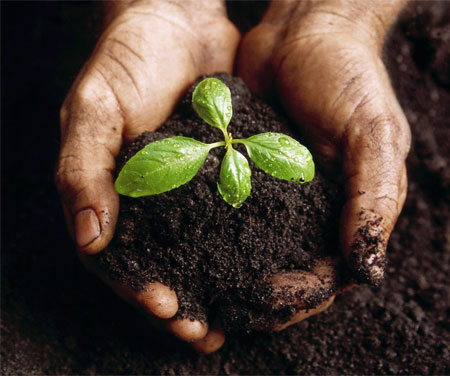
These flavor components have an elemental feel to them and are probably more a reflection of the country, region, soil composition and the fertilizers used in growing the tobacco plants.
- Barnyard – a combination of several flavors: grass, hay and earth often with some mustiness thrown in.
- Earth – a cigar that is described as earthy can have a few flavor components to it like soil (dirt), must, and even some deep vegetal flavors like moss and loam. I find this component most in Nicaraguan cigars.
- Lead – tastes like, well, lead. Embellished as pencil lead or graphite.
- Mineral – a general “mineraly-ness”, mostly lead.
- Must – this is a tough one. It’s kind of earthy and dusty but also has an aged feel to it. The best example is Cuban cigars. Cuban cigars = must.
- Salt – hopefully this isn’t the actual transfer of sweaty armpits carrying the bales of tobacco to our mouth… but this can be found in some cigars most notably Cubans, especially Punch.
Fruits
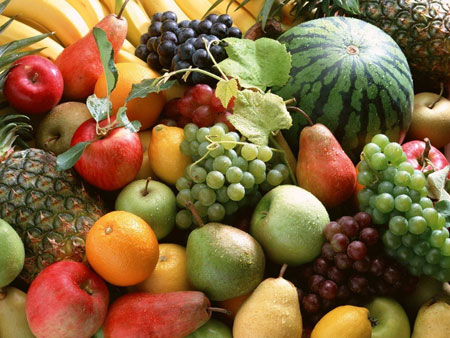
Unlike wine tasting, fruit flavors are not as prominent.
- Cherry – I’ve heard this described occasionally and have only tasted it in a few cigars, and mostly in the finish. It’s usually a very subtle flavor to detect. Try La Flor Dominicana cigars, especially the Double Ligero line to pick up cherry.
- Citrus – usually a way to describe a cigar that has a certain “bite” to it. It can be both from improper fermentation and also from the tobacco itself. Most Don Pepin Garcia cigars have an acidic (or citrus) flavor component to them.
- Molasses – a very sweet flavor.
- Orange zest – quite a recognizable flavor.
- Raisin – can’t say I really have ever picked up raisin notes, but many have.
Nuts
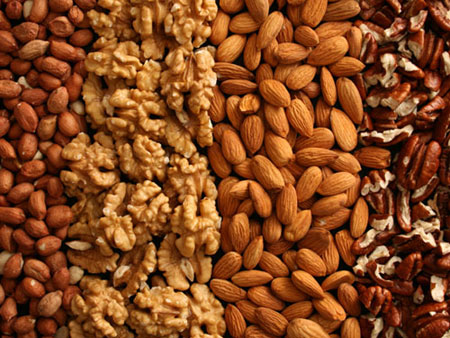
A prominent flavor in lots of cigars. A surprisingly wide variety of nuts can be detected in cigars. “Roasted” can often be thrown in front of these flavors to add a smoky element to them.
- Almond – a great flavor found often on the finish.
- Cashew – this one is a bit of a stretch for me but I’ve seen it before in Cigar Aficionado…
- Marzipan – a sweet almond flavor.
- Peanut – every now and then I can get a peanut note in milder Connecticut Shade cigars. Peanut butter is also used descriptively.
- Pistachio – another CA fave.
- Walnut – a nuttiness that’s a little dry on the palate.
Flowers

In my opinion this is where wine and cigars diverge. Some cigars have a general “perfuminess”, but no flower flavors here. Maybe rose in the aroma if you’re stretching it. Others believe there are many cigars that have floral qualities, so it is included.
- Floral – a general “perfuminess”.
Other
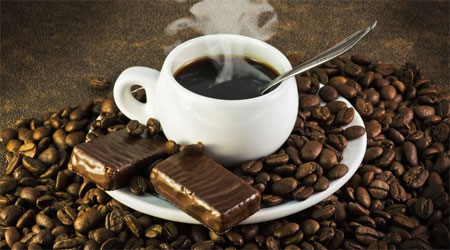
This is a pretty broad category that will be used to describe a lot of other flavors or sensations that really don’t fall into the other categories.
- Bread – an often disliked flavor. Can be further embellished as toast or dough.
- Char – a combination of flavors: meaty and smoky.
- Caramel – creamy caramelized sugar! Some Cameroons and H2000 wrappers can exhibit this flavor.
- Chocolate – this is a flavor I pick up more in the finish than in the initial inhale/exhale and is found often in Connecticut Broadleaf wrapped cigars. This can be further detailed as dark or milk chocolate and cocoa.
- Coffee – great flavor most often found in the finish and sweet spots. Can be embellished further as mild coffee, espresso, roasted coffee beans, café au lait (coffee w/ a creaminess), etc.
- Cream – not really the flavor of milk, but the general description of the type of flavors. Most creamy cigars are mild and most are of the Connecticut Shade variety.
- Honey – not sure where to put this, so it goes here. Described often in aged cigars.
- Leather – one of my favorite cigar flavor components. Leather “taste” really shows up in the exhale and finish and is tasted mostly through the nose. For some reason the Rosado shade yields the most leather flavor, so look for this in Opus X and Partagas Spanish Rosados.
- Meaty – the flavor of grilled hamburger comes to mind. A lot of rich maduros, especially from Nicaragua, can have this flavor.
- Mocha – a combination of chocolate and coffee flavors. This shows up often in the last third of a cigar once you reach the “sweet spot”.
- Musk – also known as the “animal” flavor.
- Sweet – there’s artificial sweet (sweet-tipped) and then there’s natural sweet. The natural sweetness is used to describe a cigar that has a general sugary flavor whether it be something like caramel, cocoa or marzipan. Many maduros are often described as sweet.
Not-Really-Flavor Flavors
This is a pretty broad category that will be used to describe a lot of other flavors or sensations that really don’t fall into the other categories.
- Acidic – see “Citrus” in the fruit section.
- Ammonia – not really a flavor, it’s actually what you are tasting – ammonia. Ammonia is a by-product of tobacco fermentation and improper fermentation and aging will result in a lot of ammonia left in the cigar. A huge turn-off for cigar lovers.
- Chewy – again, not really a flavor, more of an experience. A cigar where the smoke has an apparent texture to it in your mouth would be considered “chewy”.
- Dry – just like wines and tea, a cigar that has that tannic quality that dries out your mouth and teeth. Found mostly in Connecticut Shade cigars – think Davidoff. Cigar Aficionado hates this, but I’m a big fan.
- Harsh – not really a flavor per se, but definitely used to describe a cigar that may have one or several of the following components: ammonia, pepper and spice. Usually used to describe a cigar that is too young or unbalanced/muddled.
So that’s all I can really think of. Let me know if you think I have missed some or can describe some of the above better!

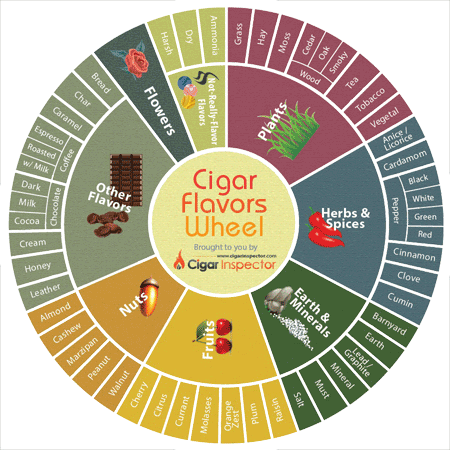
How does one relate the wheel to a cigar? For example if I’m looking for something with coffee or chocolate tones, I see this on the wheel, but have no idea what cigars are that flavor.
This is very subjectives. But in general an aged montecristo will develop this characteristics. In the new world the Davidoff n2 as well.
Wet cigarette butt is a flavor. I hate tasting it in cigars, most often Connecticut wrapped. I do like CT though.
Contrary to the description above, I generally think of a “bread” or “baked bread” flavor as being one of the best indicators of a “round” or “finessed” flavor in a cigar. Like graham crackers or roasted nuts. At the opposite extreme, it’s hard for me to imagine a “dry” tasting cigar that I would like.
I am still waiting for a study on cigar smokers reliability to taste the cigar smoke, just like they did with wine. I am willing to bet 100$, that ratings will be highly unreliable.
They proved it with expert wine tasters, I expect the same to be true to cigar smokers. BTW i love cigars 🙂
Mint. Surley mintyness.
Sandro – it’s not necessarily schooling. Some people are “supertasters” – they simply have more taste buds than the rest of us. It’s not really a rare thing. About a quarter of us are thought to be “supertasters”.
Hello everyone…I do believe these flavors exist and some people taste or acknowledge them more then others,,either cause they’ve been schooled or have a knack for flavors. I think most people can figure out if it’s a good cigar or a bad one.
Fantastic article. I’m just getting into cigars and this is really going to be a big help in developing my palate and discovering what types I like.
Great Article!
I also feel a lot of the flavor descriptions are over done, but for me a couple of things. I see creamy as more of a texture thing i.e. the smoke is smooth, has lots of volume and coats the mouth, buttery is more the flavor side. Spicy is another one I pick up and is my preferred flavor. I think of spicy as a bakers spice flavor, so cinnamon, nutmeg, cloves and allspice type thing with a hint of sweetness to it, think hot cross buns or cinnamon scrolls. Peppery on the other hand tends to be a dry type flavor and is not one I am all that partial to. Try some five spice vs ground pepper on your tongue. .
Spicy is a flavor I get from Cubans like SLR’s, Juan Lopez and well aged Partagas and also well aged Bolivars like the Petite Corona’s. Pepper I get from a lot of NC’s like My Father and Don Pepin cigars etc.
Cherry I do get from some Cubans like some of the R&J’s say Exhibition 3’s and especially from H Upman Royal Robusto’s. Gingerbread is another flavor I pick up from smokes like Ramon Allones SS, so a bit spicy but also bready.
Nutty and coffee bean flavors I get from most good cigars but couldn’t be more specific.
Please turn this into an app! I’d love to journal my smokes using this info!!
You’ve taken a mile when an inch was offered. Are you suggesting we could eat bacon, and you’d taste bacon and I’d taste pistachio? Flavors are NOT subjective. Your tongue (and mine) has different taste sensors on different parts of the tongue. We may differ on nuances, but salty is always salty, and sweet is always sweet. They are not subjective.
Similarly, those flavors i cigars are REAL; they’ve imparted to the curing leaf by essential oils and flavonoids, as well as esters.
I said you are free to enjoy cigars without bothering with the nuances of flavor descriptors; I never said they didn’t exist! Because they DO.
The cigar makers don’t make up the descriptions; cigar smokers do. It is NOT fictitious, it’s real.
@ William: I certainly enjoy my cigars… and lots of them! My point was, I feel the whole “flavor” thing is cooked up by cigar companies in an effort to make their products sound more appealing to the consumer. I don’t dispute the fact that most sticks exhibit flavor, but those flavors are purely subjective. No two palates are alike…just as no two individuals are alike. Ofit tastes good to ya..smoke it! And iI am actually intrigued by how a tobacco leaf can have different tastes/profiles. It’s why I started smoking cigars in the first place. Ha!
Scotty-Boy: Don’t be put off by taste descriptors simply because you don’t taste them. I want to make it clear, though, that folks DO taste those flavors. It’s not just some imaginative flight of fancy.
In recognizing these flavors, people are just trying to increase their enjoyment by exercising ALL their flavor and aroma senses – including the best one: consciousness.
I don’t think anyone’s out to put you down for the way you enjoy cigars. You’re enjoying them, and that’s the important thing!
Oh..and what’s the difference between spice n pepper. Could it be that one hits you in the back of the throat, whereas, the other nails you farther up your tongue (palate)? Leather…? Did the reviewer actually chew on a belt to figure out what leather tastes like? And eat dirt to taste the taste of Earth? I just don’t get what all the fuss is about, honestly. Color me as feeling it’s all pompous and unnecessary…sorry!
Great article! I hate to admit though that I struggle to discern “flavors” in a cigar. I’ve been enjoying fine cigars for many years. It used to frustrate me that I was having a tough time finding the same “flavors” in my sticks that others/ reviewers did. I would buy cigars because they had chocolate, cedar, mocha, or some other enticing “flavor”in their profile… light em up and realize I wasn’t tasting anything even close to those “flavors”. Finally, I just gave up trying to analyze the sticks and bought those that tasted “good” to me and gave away the ones that didn’t. Ha!
Great write-up Zen. I’m really working on getting more into describing the flavors and aromas I enjoy, instead of just knowing I like or don’t like this or that cigar. This helps a lot and is a great aid to everyone developing their palates. Mr. T, I think that would be more along the lines of “Animal Excrement” for dog rockets. I always assumed thats what people meant by dog rockets, the mine field man’s best friend leaves in your backyard.
I would add one more category to your wheel, probably right before “Earthy”, and that would be “Animal”. This category could be broken up to better identify a whole host of cigars classified as “dog rockets”. 🙂
@MikeMas
Thanks for the question. It’s hard to try to peer into the mind of the original reviewer, but I can give you more reason on what I could consider to be a buttery draw or something being buttery smooth. I have tasted butter flavors before in some rich Connecticut Shade-wrapped cigars. But to me a buttery draw I would take as a bit of artistic flare by the writer to state that the smoke had a velvety texture in their mouth. Sometimes the smoke can feel dense to the point that it feels like you could chew on it. Other times it feels almost liquidy – and maybe this is where the comparison to butter came in. Or it simply could have meant that the draw was nice and easy. Hope this helps!
I think clearly “buttery” is an expression of a feel in the mouth, rather than a flavor. I don’t recall ever seeing it used, but probably I have.
More than anything, I think that it’s because different people, who of course bring their life experiences wherever they go, have several different ways of expressing the same flavor/sensation.
Hey, maybe you can explain one I’ve been seeing a lot recently: Buttery.
I usually see it used in the context ‘buttery smooth’ or ‘a buttery draw’. A flavor, or simply an embellishment on smoothness of the draw?
Thanks for the great post!
Thanks for your kind words guys. I’ll be updating it with some of the suggestions and will also have somebody design a flavor wheel based on the content of this article.
@Tee
For a lot of people “spicy” means “peppery”, more precisely black pepper. Nicaraguan puros have a lot of it (especially in the first third). Again, it’s quite a vague term.
@Ross
Glad you enjoyed this post. To answer your question, for the most part, it comes naturally. Just like wine, it’s just the differences in the varietals, soil, and location. All of these things and more contribute to a premium cigars flavor.
Great job!! I’m still new to cigars but I like to think I have an acute sense of smell and taste. I’ve noticed cigars are made up of a lot of the tastes you have so accurately described. That brings me to this question. How do they get those tastes in the cigar? Is the tobacco chemically treated to have those flavors? Or is it that the tobacco naturally has those flavors?
Great article.
I would add currant and plum to the list of flavors I’ve experience in more complex cigars.
I’m interested in your opinion of “spicy.”. All too often, I am overwhelmed by a cigar that is too spicy. Some of the larger Ghurkas come to mind. Personally, I don’t care for it; reminds me of Kung Pao Chicken where all you taste is the chili..
Thanks for doing this. Just like the proverbial “tasted like smoke; I liked it” review you used above, I get bored reading reviews that just say (usually repeatedly) “wood, nuts, earth, and some coffee, with a spicy finish.” Really?!? Those flavors could pertain to nearly every cigar ever made, or the vast majority of them anyway. A good reviewer will say what proportions these flavors are in and how they developed; the kinds of wood or nut flavors they are getting; what type of earthy flavors – I’ve had cigars that tasted of dry humus like peat, and others that tasted of wet clay; what type of coffee (light, dark, espresso, mocha); and what spices they are getting from the cigar. Hopefully your list helps folks to develop this skill.
BTW, I would add that cumin also has a musky, almost BO-like smell/taste to me. That’s one of the ways I identify it.
Thank’s for a great article. But I feel that the habano wrapper offers a lot of coco or chocolate flavors. I agree though that this is mostly noticed at the retro hale of the cigar. Notably in Padron series and Torano’s Master Maduro lines. Same goes for raisin like flavors in the Torano’s Exodus 50 year series,Aroma de Cuba Mi Amor series as well again at the retrohale. But that’s just my two cents. Great article!
I’m lost when it comes to flavor descriptions. I just know what I like when I taste it. I smoke a good amount of Cuban Cohibas and the flavor has been described as “grassy”. Good description. Ive seen a better description not on this post for Cohibas, “dried beans”. Great description of “grassiness”. Cohibas taste like the smell of a handful of dry kidney or white beans, shoved in your face. It is good!!!
I have always felt that what one calls lead should be referred to as graphite as well. One additional note that I come across is orange zest. Very different than citrus.
Thank you for the great write up.
I’m glad that you saw fit to note that some of these flavor descriptors are not necessarily ones that you have been able to pick up. I do think that “lead” should be changed to “pencil lead”, which is graphite. Who wants the actual element lead in their smoke? 😉 I tend to think of the mineral flavor as more like iron or tin.
Thanks for a great article!
What happened to MOLASSES as a flavor? Notable example: PINAR DEL RIO Small Batch Maduro. Pure MOLASSES, from start to finish, and the flavor remains very nearly unchanged. I think this flavor is sometimes called “raisins”, but “molasses” fits better. I enjoyed that PDR a lot, but the flavor profile was boring, because it never changed. I couldn’t finish it, because I was bored.
Holy cr@p! What a great article this is. Thank you for your time involved in this. I truly love it. Really deep and specific details. Now we have a task to taste and nose things we missed before. And the graphic (chart) part is just wow. Thank you sir!
Awesome post. Thanks for this. Helps me better refine my palate.